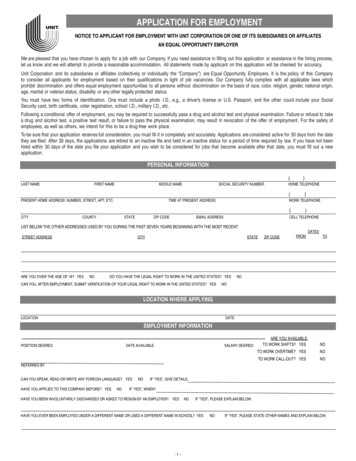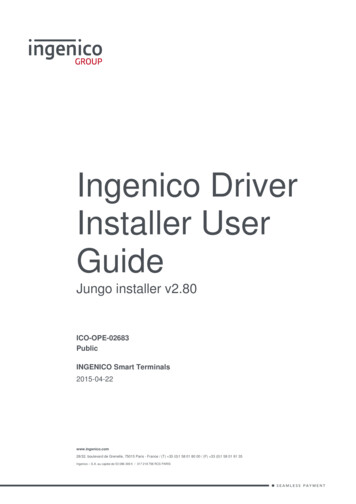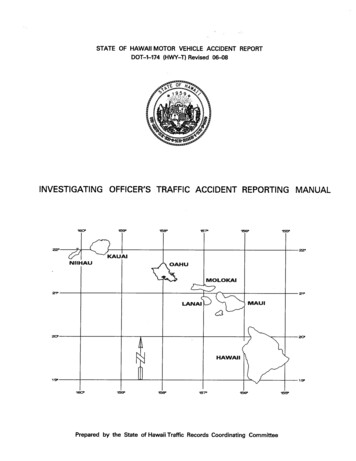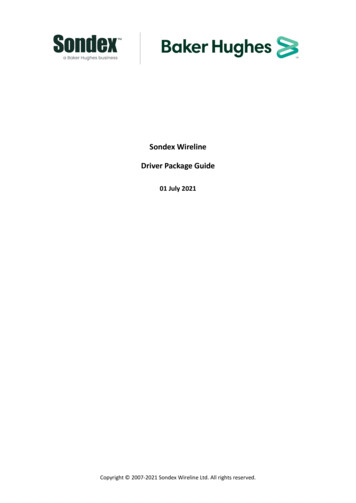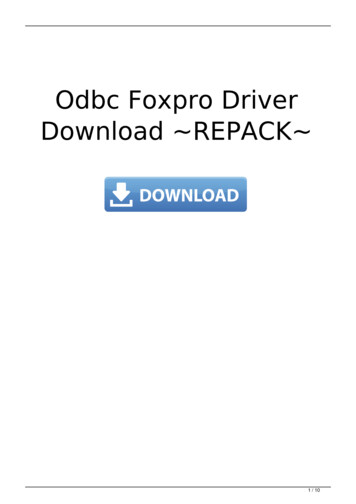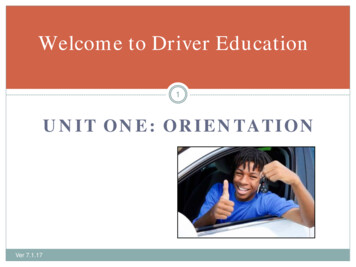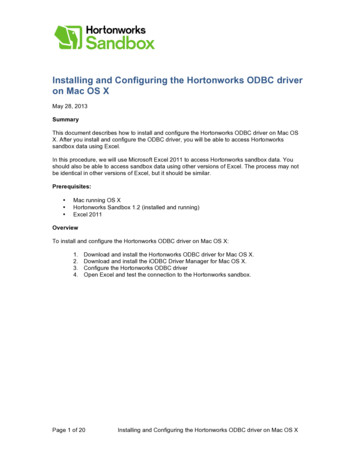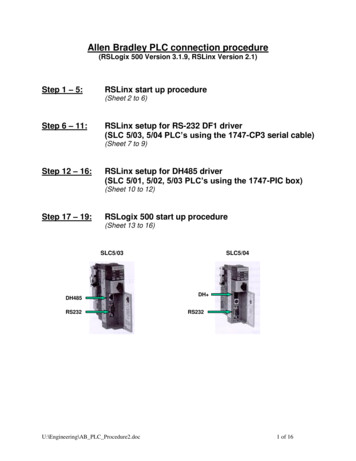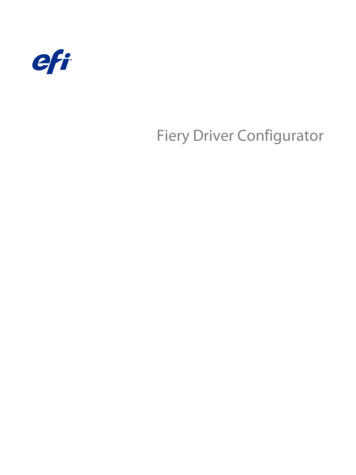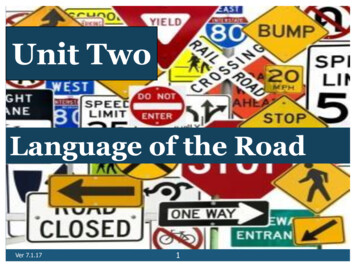
Transcription
Unit TwoLanguage of the RoadVer 7.1.171
What Do You Know About Signs, Signals, & Pavement Markings ?Unit Two ObjectivesWhat has millions ofmiles & over200,000,000 drivers andvehicles?Can a driver know if aninterstate road is goingNorth to South or Eastto West?What should a driverdo at a flashing redsignal?Can a driver cross asingle solid white line?What is black and white andsometimes red all over?Ver 7.1.172
What Do You Know About Signs, Signals, & Pavement Markings ?Unit Two Objectives Student will be able to describe the laws for sharing the road safely withemergency vehicles, school buses, pedestrians, motorcycles, and bicycles. Student will be able to define the concept of the Highway TransportationSystem and evaluate what impact that concept has on safe driving. Students will be able to describe the function of signs, signals, and lanemarkings and the potential consequences of not following those markings. Students will evaluate how traffic control devices impact safety includingright of way and risk and the impact of failing to obey the laws pertainingto traffic control devices. Student will evaluate the risks of failing to adhere to signs and roadmarkings including the risks of speeding and distraction.Ver 7.1.173
What Is The Highway Transportation System?4The system of roads, vehicles, and drivers that includesEVERY person and EVERY vehicle and EVERY road atany time in the United States.Over4,000,000miles ofroadOver250,000,000 vehiclesVer 7.1.17
Highway Transportation System: Everyone On The Road At Anytime5Ver 7.1.17
What Is The Language Of The Road?6The “language of the road” is composed of: Signs Signals Pavement MarkingsVer 7.1.17
Signs7Remove all the traffic lights, yellow lines,one-way systems and road markings, andlet blissful anarchy prevail. I imagine itwould produce a kind of harmony.-SADIE JONES, ENGLISH WRITER AND NOVELIST, 1967 CURRENTBut would it?Ver 7.1.17
Guide Signs: Communicating Where You Are GoingGuide Signs can be RED, WHITE, & BLUE to indicateInterstate numbers, BLACK AND WHITE to indicate USroutes and state roads, GREEN to indicate exits or mile markers,BLUE to indicate motorists’ services, or BROWN toindicate special points of interest. Interstate system guide signs – Ver 7.1.17Any two digit interstate is a road that goes from one state toanother. Marked with blue shield shaped signs with a redstripe. Even numbers go from EAST to WEST. Odd numbers go from NORTH to SOUTH.8
Guide Signs: Communicating Where You Are Going9 On the interstate system, three digit numberswith an EVEN first number are beltways goingaround a city like: On the interstate system, three digit numberswith an ODD first number are spursconnecting an interstate to anothercommunity.Ver 7.1.17
Guide Signs: Communicating Where You Are Going10 U.S. Routes - Black and White Shields on a Square Sign US routes preceded the interstate system.Many run through cities and towns.Odd numbers generally run north – south.Even numbers run east – west. Maryland Routes – Usually black and white squares Smaller routes maintained by local governments.Might know them by street names rather than route numbers.Ver 7.1.17
Guide Signs: Guiding You To Destinations11Green Guide Signs: Where are you going? How faruntil you get there?What exit you mayneed to take & whatlane to be in to takethat exit.How far you are fromyour destination?Mile markers tell you where youare on an interstate highway.Ver 7.1.1711
Guide Signs: Guiding You To Destinations And Services12Do you need food, fuel, or ahotel?Blue signs will tell you whatis available at an exit.Ver 7.1.17Do you want to gosomewhere?Brown signsindicate recreational“stuff.”
Warning Signs: Real Risks13These signs tell adriver a median isupcoming; thenumber of lanes ischanging; or trafficis entering from adifferent direction.What are the possible hazards or risks aroundthese types of road changes?Ver 7.1.17
Warning Signs: Real Risks14These signs warn adriver ofintersections androad crossings.What are the possible hazards or risks aroundthese types of road changes?Ver 7.1.1714
Warning Signs: Real Risks15These signs tell a driver the road ischanging direction or is becoming curvier.What are the possible hazards or risks aroundthese types of road changes?Ver 7.1.17
Warning Signs: Real Risks16These signs alert a driver to specific issueswith road conditions.Ver 7.1.17
Warning Signs: Real Risks17 Construction Zones Railroad Signs Incident SignsWhat are the risksthat go along withthese signs?Ver 7.1.1717
Warning Signs: Possible Risks18Ver 7.1.17
Regulatory Signs:Regulate The Flow Of Traffic And Let Drivers Know The Law19Regulatory signs - signs with black, white or redmarkings telling a driver what actions are legaland illegal.Ver 7.1.1719
Regulatory Signs:Regulate The Flow Of Traffic And Let Drivers Know The Law20Regulatory signs - may have red circles withlines through them to indicate what MAYNOT do.No right turnVer 7.1.17No U turnNo left turn
Regulatory Signs :Regulate The Flow Of Traffic And Let Drivers Know The Law21Regulatory Signs: Speed Limit sswayWhere would a driver find these posted speed limits?Ver 7.1.17
Speeding: Fact Or Fiction22 You can go 10 miles over the speed limit, and youwon’t get stopped by a police officer. Every expressway has a speed lane where you can gofaster than the rest of the road. If you are passing another vehicle, you are allowed toexceed the speed limit.Ver 7.1.17
Speeding Facts23Ver 7.1.17
What’s The Difference Between These Two Signs?24Ver 7.1.17
Regulatory Signs:Regulate The Flow Of Traffic And Let Drivers Know The LawWhen travelling ona road marked 40mph,how fast can adriver legally go?The speed limit is 55mph. You observecars driving at 80mph. How fast canyou go to keep pacewith traffic?Ver 7.1.1725
Speeding & Law Enforcement26VIDEO TO BE DISPLAYEDDURING CLASSROOMINSTRUCTION.Ver 7.1.17
Regulatory Signs:Regulate The Flow Of Traffic And Let Drivers Know The Law27Do you know what this is, anywhere in the world?Ver 7.1.17
So What Are You Supposed To Do At A Stop Sign?28Come to a complete stop!!!! WHERE? Before your vehicle crosses the stop line, moves into thecrosswalk, or enters the intersection. WHO? Yield to pedestrians, cyclists, any driver to your right, anydriver already in the intersection, any driver who got to the stop signbefore you. HOW? Look to your right, then your left, and then your right again. WHEN? When the intersection is clear and there is enough space inany approaching traffic, you may proceed. Remember that all driversan at intersection MAY NOT BE REQUIRED TO STOP.Ver 7.1.17
Where are you supposed to stop?BDoes this carstill have tostop at the stopsign?CAIf all three cars arrived at the same time andyou are in CAR A, who goes first?Ver 7.1.1729
Regulatory Signs:Regulate The Flow Of Traffic And Let Drivers Know The Law30VIDEO TO BE DISPLAYEDDURING CLASSROOMINSTRUCTION.Ver 7.1.17
Regulatory Signs:Regulate The Flow Of Traffic And Let Drivers Know The Law31Yield Signs – What and How – Basic Overview A yield sign means a driver should let other roadusers go first. Usually found when two roads cross or combine. If you see a yield sign ahead, be prepared to letother drivers crossing your road go ahead of you. May have to stop if there is no gap. And don't forget about bicycles and pedestrians.You must always yield to them.Ver 7.1.17
How To Yield32VIDEO TO BE DISPLAYEDDURING CLASSROOMINSTRUCTION.Ver 7.1.17
Signals33Ver 7.1.17
Traffic Signals34Ver 7.1.17
Flashing Signals35Flashing red – adriver must stopbefore entering theintersection.Flashing yellow – adriver must slowdown and proceedwith caution whengoing through theintersection.Ver 7.1.17
Signals36Directional Arrows A red arrow tells a driver that he/she may notturn in the direction of the arrow. A yellow arrow tells a driver that he/she maycomplete any turn when it is safe to do so butshould be prepared for the light to change. A green arrow tells a driver that he/she may turnwhen it is safe to do so.Ver 7.1.17
Intersections And Traffic Lights37VIDEO TO BE DISPLAYEDDURING CLASSROOMINSTRUCTION.Ver 7.1.17
Pavement Markings38Ver 7.1.17
Pavement Markings: Yellow39 Separate traffic traveling in opposite directions. Mark the left edge of the road on dividedhighways, one way roads, and ramps. May be Single Double Solid Dashed or brokenVer 7.1.17
Pavement Markings: Yellow40Dashed yellow linemeans the drivermay pass on eitherside of the road.Doubleyellow linesmeans thedriver maynot pass oneither side ofthe road.Single yellowline means thedriver may notpass on eitherside of the road.Ver 7.1.17A yellow solidand dashed linetogether meanthe driver on theside of the roadwith the dashmay pass whilethe other sidedriver may not.
Pavement Markings:What Does A White Line Or Marking Mean?41White lines can be Single Double Solid Dashedor brokenWhite lines are usually used: To separate traffic traveling in the same direction.To indicate where you must stop (stop line).To mark the right edge of roadway.Ver 7.1.17
Pavement Markings: White Road Markings42Separates lines of traffictraveling in the samedirection. Crossing is notrecommended but isallowed.Ver 7.1.17Indicates theright side of theroad.
Pavement Markings:What Does A White Line Or Marking Mean?43 White pavement markings mark special lanes:HOV (High Occupancy Vehicle) Bike lanes School or pedestrian crossing Rail crossings Extension of lane indicators into intersection Ver 7.1.17
Pavement Markings: BikeLaneVer 7.1.17Stop Line44
Pavement Markings: Intersections & Expressways45In what directions would vehicles begoing?Where would a driver be allowed to go?What could a driver not do?Ver 7.1.17
Pavement Markings: Intersections46What do theselines indicate?In whatdirections canthese cars go?Ver 7.1.17
Review for Unit Two471) What is the difference between real risk and2)3)4)5)6)7)possible risk?What are some examples of regulatory signs?What are some uses of white pavement markings?What are some uses of yellow pavement markings?Describe the process for stopping your vehicle?What is the difference between a yellow speed signand a white and black one?What are some of the common myths about speedlimits and speeding?Ver 7.1.17
What’s next? Unit Three: Getting Started48 Is there really such a thing as an emergency brake? How do I make my vehicle fit me? If I have an airbag, do I really need a seatbelt? What do all the lights on my dashboard mean?Ver 7.1.17
49END OF UNIT TWOVer 7.1.17
Unit Two Objectives Ver 7.1.17 2 Student will be able to describe the laws for sharing the road safely with emergency vehicles, school buses, pedestrians, motorcycles, and bicycles. . right of way and risk and the impact of failing to obey the laws pertaining to traffic control devices. Student will evaluate the risks of failing to .

